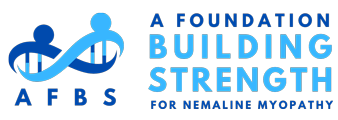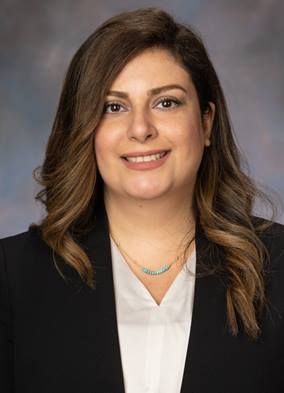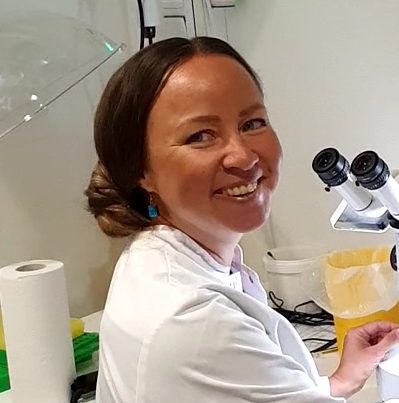Our goal is to find treatment for Nemaline Myopathy by funding targeted research and support studies that pave the way for regulatory approval.
Active Research Projects
Learn more about our active research projects or read about our completed research projects below.
NEM6: From Pathophysiology to Therapy
In 2002, a research group, including Dr. Coen Ottenheijm, described a large Dutch family with a new type of nemaline myopathy. This disease, NEM6, is characterized by muscle weakness in the upper legs and arms and a remarkably slow relaxation of the muscles. This phenomenon is not known in the other types of nemaline myopathy. In 2010, the team discovered the gene involved, KBTBD13, and in 2020, they unraveled how the genetic errors in KBTBD13 lead to slow muscle relaxation. For that research, they developed a mouse model with the same genetic error as the patients. These mice also develop the muscle disease NEM6.
Dr. Ottenheijm’s project aims to test NEM6 therapy in mice.
The goal for the first year was to determine the natural history of the disease in mice so that they could determine the timing of therapeutic intervention. The first data set shows that mice are almost asymptomatic until the first month after birth (similar to patients) and have a strong phenotype from month 3 onwards. So, in the coming years, they will test the therapy on month 1 to see if the development of the disease can be prevented, and at month 7 to see if they can suppress the disease if it is already there.
This project is being co-funded with Prinses Beatrix Spierfonds.

Dr. Coen Ottenheijm, Dr. Tyler Kirby, Dr. Nicol Voermans, Dr. Annemieke Aartsma-Rus
Developing Therapies for Nemaline Myopathy
Nemaline myopathy (NM) is a genetic disorder caused by mutations in 12 genes that regulate the function of skeletal muscle. The common link between all the known NM genes is that they affect actin-thin filaments crucial for skeletal muscle strength and function. Mutations in three members of the Kelch gene family, KLHL40, KLHL41 and KBTBD13, result in rare forms of NM.
Dr. Gupta’s work has led to the development of mouse and zebrafish models of NM-causing Kelch genes. Now, Dr. Gupta’s studies are focused on developing therapies for these rare forms of myopathies by (a) a gene replacement approach, in which a normal copy of the disease-causing gene is added back to patients to restore the muscle function, and (b) testing several hundred FDA approved drugs in animal models of NM to potentially repurpose those having a positive effect in muscle function.
An update to the previous report informs that Dr. Gupta’s team has now focused on injecting the best out of two original gene therapy constructs of the Human KLHL40 gene they generated into the severely affected KLHL40 mouse model (they don’t survive more than 5-6 days). The researchers may have found the cause of the poor survival of this animal model. They observed a postnatal growth defect in the heart (smaller size, reduced cardiomyocyte numbers, and large gaps between the cardiomyocytes). There is strong evidence that KLHL40 is required for skeletal muscle growth after birth, and this new observation suggests that KLHL40 is also critical for cardiac muscle growth. Dr. Gupta is teaming up with specialists to characterize the specific heart defects.
This observation drives the hypothesis that therapeutic approaches to KLHL40 should focus on improving muscle and heart function. Fortunately, the therapeutic gene the team is administering to these mice has a promoter driving the expression of KLHL40 in both skeletal and cardiac muscles.
In this reporting period, the researchers tried several different concentrations of KLHL40-AAV. The lowest dose did not improve life span or muscle function, whereas the mid-range dose improved the treated pups’ survival by a few days. However, no treated mutant pups survived beyond days 10-11 after birth. They then tested a higher dose, which resulted in further improvement in the pups, and a weight gain plateau was observed 22 days after birth. To confirm this good result, they are currently testing this dosage of AAV in multiple litters. This is a slightly high dosage of AAV9 compared to similar studies; therefore, they are analyzing the treated mice for any toxic effects on other organs, such as the liver and lungs. Stay tuned for further updates in about six months.
They also advanced in screening FDA-approved drugs in the zebrafish model of KLHL41. They screened ~1,400 of these drugs, and after reaching the mark of 1,500 compounds screened, they will move to the following stages of determining the best drug/pathway combination for therapeutic development in NM. In addition, they will be testing these drugs and pathways in other forms of nemaline myopathy, such as NEB and ACTA1 models.
Development of Gene Therapy for ACTA1-based Nemaline Myopathy
Dr. Rashnonejad’s lab is working on a new gene therapy to treat NEM3 by turning off the harmful mutated gene and replacing it with a healthy copy.
They created and tested a special class of genetic tools, microRNAs (miRNAs), to target and silence the defective copy of the ACTA1 gene while allowing the healthy gene to work. In their initial tests in cells, they obtained a reduction in harmful protein clumps called nemaline rods. They then created delivery vehicles (AAV vectors) carrying these genetic tools and did a pilot test in mice.
When they injected the mice with AAV-miRNA and AAV-ACTA1 constructs, they observed a significant reduction in the harmful gene’s activity, indicating that the approach works in animal models.
In the last few months, they focused on manufacturing the therapeutic product and expanding the colony of the ACTA1 mouse model (Acta1H40Y), getting ready for a pre-clinical trial of this gene therapy in vivo.
They are now moving into the next step, where they will combine the knockdown of the mutant ACTA1 with the introduction of the healthy gene in both normal and H40Y mice. They will also determine the safest and most effective dose of this gene therapy. The goal is to show that this new treatment can benefit mice with NEM3, bringing us closer to a potential therapy for humans.
Nemaline Myopathy Biobanking Program
Functioning as a secure repository for tissue samples obtained through various medical procedures, including surgeries, fetal sampling, autopsies, and muscle biopsies, the Beggs Lab lab aims to advance scientific understanding and therapeutic development for Nemaline Myopathy. With a mission to support patients and families in their contributions to medical research without financial burdens, the biobank welcomes tissue donations from individuals with NM of all ages and genetic subtypes. The centralized human tissue samples and medical data are critical to advancing research, aiding clinical trial planning and follow-up, and fostering collaborative advancements in the field.
Identifying and Correcting the Pathological Drivers of Nemaline Myopathy in Stem Cell-Derived Engineered Skeletal Muscle Tissues
A significant impediment to developing effective treatments is the creation and validation of suitable human models that recapitulate the disease phenotype with sufficient fidelity to predict whether a novel treatment will be successful in clinical trials. Dr. Mack’s research aims to create a derived human stem cell model of Nemaline Myopathy (NM) and test potential therapeutic methods to treat the disease.
In this project, they are differentiating stem cells from NM patients that have disease-causing mutations in the skeletal muscle actin gene (ACTA1) into skeletal muscle and then create 3D muscle bundles. These engineered muscle tissues (EMTs) are then suspended between two small posts—one stiff and one flexible. The deflection of the flexible post is used to calculate the force the muscle bundle can generate after electrical stimulation (the equivalent to a nerve impulse).
The research team has successfully generated 3D muscles from the ACTA1 mutant cells and 3D muscles from CRISPR-edited (mutant ACTA1 allele-deleted) patient-derived cells. In the past six months, the group optimized the experimental conditions of this tissue model system to measure the contractile and pathological hallmarks, which would serve as the basal settings to evaluate the efficacy of experimental therapies.
The EMTs generated from each group, the ACTA1 deficient and the ACTA1 corrected cells, were exposed to programmed electrical stimulation to compare their contractile force generation in response to stimulation.
Through the 21-day time-course of contractile force recordings, they found that the ACTA1 mutant group showed significantly impaired twitch and tetanic force generation compared to the CRISPR-edited muscle tissue. Moreover, immunofluorescence imaging on the ACTA1 mutant muscle tissue showed disorganized sarcomere structures but did not show evident nemaline body formation on day 21. Further studies are underway to characterize tissues at days 40 and 60 to see if the impaired sarcomere produces nemaline rods later.
During this reporting period, Dr. Mack hosted Dr Joshua Clayton from Prof Nigel Laing’s team (Perth, Australia). This collaboration with this previously AFBS-funded research team showed that iPSC-derived myogenic cells from two additional ACTA1 NM patients (one dominant, one recessive) could also produce 3D EMTs. Preliminary analysis of these data shows potential contractile deficits compared to controls.
The team is now getting ready for the next step, which consists of testing potential therapeutic interventions, including 1) correcting the mutant copy of the ACTA1 gene, 2) introducing a small molecule that can help the misfolded actin protein assume a more normal shape, and 3) two strategies to increase the expression of cardiac actin to compensate for the mutated skeletal muscle actin.
Soft Robotic Garments for Assisting Lower-Limb Function in Children with Nemaline Myopathy
Exoskeletons and suits are an emerging technology for mobility impairment, but no such technology is commercially available for children. Motivated by this missing gap in technology, our goal is to amplify the functional independence of children with NM through the development of soft robotic garments that physically assist the lower extremities. The singular goal of the research is to actualize and demonstrate a lower limb exosuit prototype (soft robotic garment) that can provide physical assistance to a pediatric user during sit-to-stand, maintenance of balance, and stand-to-sit actions. Long-term we envision our results to provide foundational technology to realize comfortable, low-cost, high power wearable robots that seamlessly interface with human users, adapting in synchrony to provide continuous ambulation assistance.
Read more: Modular and Reconfigurable Body Mounted Soft Robots
Completed Research Projects
Read about completed research projects and find additional resources for researchers below.
Exploring the Potential of Mavacamten as a Treatment for Nemaline Myopathy
Drs. Ochala and Laitila at the University of Copenhagen, Denmark, discovered that the conformation of myosin heads was abnormal in isolated muscle fibers from NM patients with NEB mutations. This dysregulated state of myosin is known to consume five times more energy (ATP) than normal and is thus likely to negatively affect muscle metabolism. The researchers tested a recently FDA-approved drug, Mavacamten, targeting the altered myosin heads conformation and were able to decrease the energy consumption to normal levels.
Unfortunately, this positive effect didn’t translate to the in vivo study. In contradiction with their initial hypothesis, a four-week administration of this drug in the NEB-deficient mouse model was not sufficient to rescue the muscle energy deficiency. These results then highlight the need for future studies focusing on either higher dosages or longer treatment periods. We praise the research team for putting together a manuscript with all this data that will be published so the field can learn from this experience.
Correcting Muscle Function in Nemaline Myopathy by Mutation Independent Approaches
This study found that removing the NEB-chaperone protein, NRAP, totally and partially, in an NEB deficiency model of zebrafish, modestly but significantly improved survival, swimming distance, myofiber and sarcomere organization while reducing protein aggregates.
They showed that NRAP down regulation results in an improvement in skeletal muscle function and survival, making attractive the idea of developing an NRAP inhibitor as a potential therapy, at least for NEB patients but probably also transversal to other NM genotypes. The team aims to test potential inhibitors of NRAP in mammalian cells and animal models in the future.
Novel Gene-Based Therapy
This team used a “cut and repair” strategy with CRISPR/Cas9 to show that they can replace exon 55 in cells from patients with NEB exon 55 deletion. When testing the strategy in the Mouse model they discovered a flaw in the model and have successfully generated a new model which should have a phenotype more comparable with human NEB-related NM by exon 55 deletion. Using this new mouse model they are designing the strategy to repeat the Gene Editing (CRISPR/Cas9) strategy. They will also pilot testing an alternative repair methodology called PASTE, and a gene therapy approach using a “miniNEB” type of gene.
Inhibitor Molecule to Myostatin; Gene Replacements for KLHL41
This study tested an inhibitory molecule (antibody) to the protein Myostatin. They observed a modest improvement in muscle function and size in a mouse model of typical nemaline myopathy with compound heterozygous nebulin mutations. These results suggest that inhibition of myostatin could be of therapeutic value in non-severe forms of NM warranting further studies. They have also tested how increased protein levels of KLHL41 affected muscle function in their nebulin-based NM mouse model. Unfortunately, decreasing protein levels of KLHL41 appeared to have no effect on muscle function so this approach doesn’t seem to offer therapeutic potential.
Testing Novel Genetic Therapies for ACTA1 Nemaline Myopathy (NEM3) – Harnessing Patient Cells
This completed study produced 4 ACTA1 patient-derived cell lines to use as a sharable “Therapy Discovery Platform”. The 4 cell lines are induced pluripotent stem cells, iPSCs from 4 different patients with different ACTA1 mutations. They started to test gene editing tools (CRISPR/Cas9) to calibrate future potential therapeutics. AFBS promoted a collaboration with Dr. David Mack (University of Washington), a new grantee who will use those cells to create 3D muscles to test different therapeutic modalities.
Drug Repurposing for the Treatment of NEB Nemaline Myopathy
This completed study screened a large FDA-approved chemical library to identify compounds that improve swimming performance in a zebrafish nemaline myopathy model (NEB). They found one drug increasing swimming performance in the zebrafish model. However, whilst the swimming performance was improved, the drug had deleterious effects on other aspects of the phenotype, requiring further investigation to determine if the drug may be suitable for the treatment of nemaline myopathy.
Uncovering the Mechanism of Myosin Dysfunction in Nemaline Myopathy – A Potential Target for Therapy
This completed study aimed to uncover how myosin is dysregulated in nemaline myopathy. The team observed that the conformation of myosin heads was abnormal in isolated muscle fibers from NM patients with NEB and ACTA1 mutations (but not from TPM2 and TPM3) when compared to control healthy subjects. This dysregulated state of myosin is known to consume five times more energy (ATP) than normal and is thus likely to negatively affect muscle metabolism. These encouraging results originated a new proposal submission whose aim is to test a recently FDA-approved drug, in a NEB (and potentially in an ACTA1) mouse model.
Research Partners
With strategic funding, we invest in scientific experts and world renowned research institutions can focus on their research, making breakthroughs and bringing us closer to life-changing treatments and cures.


Additional Resources
We have provided significant funding for and have connections to multiple NM experts. Through their research, available resources include numerous publications as well as murine models with phenotypes typical of moderate human disease.











